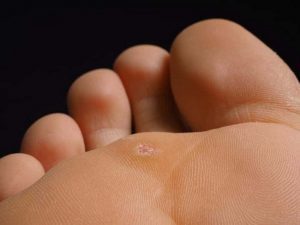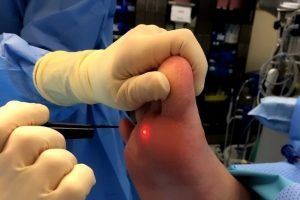Plantar warts on the skin of a viral nature are also called corn. It is clear from medical terminology that such formations are localized at the base of the feet and branches. In terms of oncological risk, they are not dangerous, but they cause great discomfort while walking due to painful compression.
Causes of plantar warts
All types of warts, including plantar warts, are caused by human papillomavirus (HPV). You can get it through close contact with infected people or through daily life. The virus dies quickly from the sun, but it feels good in high humidity. Therefore, HPV infection most often occurs in baths, saunas, swimming pools. Microtrauma and cracks in the skin, as well as reduced immunity, contribute to the penetration of the virus into the body.

With strong protective properties of the body, the post-infection virus can remain in a deplorable state for an indefinite period of time. But if immunity is reduced, it actively begins to multiply, provoking warts of different localization on the skin. In their case, it is the only case in which HPV subtypes 1, 2, 4, 27 and 57 are most often responsible.
Many imaginative factors contribute to the appearance of such formations:
- Shoes that are too tight or too small;
- Frequent wearing of high heels;
- Various deformities of the ankle (including flat feet);
- Various diseases of the joints of the feet (arthritis, arthrosis, etc. ).
Warts on the feet are more common in people with excessively dry skin and hyperkeratosis.
Thus, the causes of plantar warts are the same in all cases (HPV infection), but the predisposing factors are different. The number and size of elements on the skin depends on them and the state of immunity.
What plantar warts look like
A wart on the feet looks like a rounded growth on the skin. It can be of different sizes, but rarely larger than two centimeters in diameter. It rises above the level of the skin by no more than three millimeters, but at the same time it goes deep along with the root. The color may not differ from the surrounding skin, or it may be darker or lighter. Often such formations have a yellow or gray tinge. Visually, when looking inside the elements, black dots or lines are visible (they are also clearly visible in the photo). This is what capillaries look like, in which blood clots form, through the masses, due to compression of the corneal vessels.
Initially, the plantar wart has a smooth surface. Over time, it becomes hard, rough, thickening. It is the horny masses that give these warts their yellow color.
An important symptom of plantar warts is pain during compression. Each step puts severe pain on the patient.
These warts are very similar to plantar calluses. Corneal-like is particularly pronounced due to severe pain in both formations. The main difference is that there is no skin pattern on the surface of the warts, while it remains on the calluses.
Diagnosis of plantar wartsA competent dermatologist diagnoses this disease based on only one clinical picture. In some cases, additional dermatoscopy is needed. The absence of a skin sample on the formation and the presence of blood-clotting capillaries in its structure confirm this diagnosis.
Treatment of plantar warts

Plantar warts are more complex than similar formations in other areas due to their deep penetration. In the case of small and newly formed elements, necrotic external preparations may be used. Large and deep warts are surgically removed. At the same time, old formations should first be softened with keratolytic agents.
External preparations for removing warts
In some cases it is possible for such formations to self-destruct. But because plantar warts are quite painful, patients do not want to wait and try to get rid of them as soon as possible.
Any plantar wart treatment with necrotic effect is prescribed to remove small and superficial elements.
These products contain acids that coagulate skin proteins, causing necrosis. Medicines that contain a cooling agent have a similar effect. But they necrosis by freezing tissues, not by chemical damage.
All of these drugs are used in the formulation. It is necessary to strictly monitor that the substance does not get into the surrounding tissues as this will cause them to burn. After treatment, the wound will remain at the site of the former wart, which will be covered with crust. After healing it falls down on its own. You can carry out such treatment at home, but only with a doctor's advice.
This way plantar warts can be removed only by small size and superficial penetration of the skin. For large elements, you should choose other methods of removal, as incomplete destruction of the wart tissue will inevitably lead to its recurrence.
Surgical methods for removing plantar warts

There are several ways to remove a plantar wart. Gentle methods are preferred:
- Laser removal;
- radio wave knife;
- cryodestruction;
- electric card.
All of these procedures are performed on an outpatient basis. Patients can go home orally, within minutes of their completion, just need regular wound healing at home.
The most effective and safest method to get rid of plantar warts is excretion with a laser or radio wave knife. When they are held, the vessels experience immediate coagulation, which is a good prevention of bleeding and secondary infection. Complications of removing skin growths using these methods are extremely rare. The same cannot be said of cryodestruction and electrocoagulation, so these methods of treatment have experienced a background and are rarely used.
If the warts are large or old (covered with a large amount of corneal mass), it is recommended to treat them with keratolytics for two weeks before starting the treatment. Salicylic ointment or acid and other preparations are prescribed for this purpose. Thus, it is possible to remove part of the corneal scales, making the formations softer and richer. This will make it easier and faster to remove the wart.
In rare cases where many items are present or there is a suspicion of their nature, your doctor may recommend a surgical incision with a scalpel. With this method of wart removal, the rehabilitation period and the high risk of scarring are much longer, so it is used only under strict markings.
Properties of plantar warts in children
Plantar warts are quite common in children over the age of five because they often run barefoot, get injured and do not always follow the rules of personal hygiene. Immune dysfunction due to regular contact with sick children (in kindergartens and schools), leading to an increase in warts.
Treatment of such formations in children is best done with external agents. You can try to clean the shallow elements using salicylic ointments followed by pumice. Immunomodulatory medications have proven well. With regular use, they can remove it in a few weeks.
If the elements are deep, apply necrotic agents or remove with a laser or radio wave knife.
Prevention of plantar warts

It is absolutely impossible to protect yourself from warts, but you can reduce the risk of them developing. To do this, you need to act in two directions: eliminate predisposing factors and stimulate the body's defenses.
To achieve the first goal, you need:
- Follow the rules of personal hygiene (do not walk on foot in public places, wash your feet daily and treat wounds and injuries in a timely manner);
- Choose comfortable shoes by size; Timely
- to prevent foot deformity and to treat diseases of the joints.
Healthy lifestyle, sports, strengthening, taking vitamin complexes and taking immunostimulatory medications prescribed by your doctor will help you maintain a good level of defense of the body.
In case of excessively dry skin and hyperkeratosis, it is recommended to do medical pediculosis and skin regularly. In case of excessive sweating of the feet, you should use special means to treat hyperhidrosis. By following all these rules, the risk of developing warts on the soles of the feet will be minimal.
Plantar warts are not a dangerous disease, but they cause pain when walking. Fortunately, there are many ways in modern medicine to get rid of it quickly and with minimal new risk factors. To do this, you should consult a dermatologist and strictly follow all his appointments and recommendations.














































































